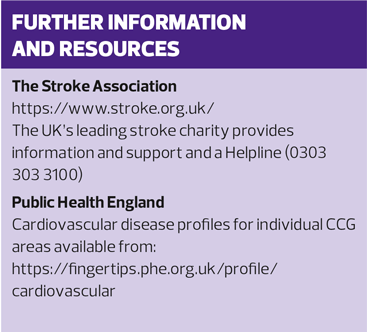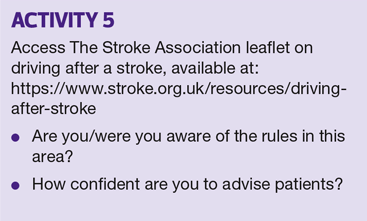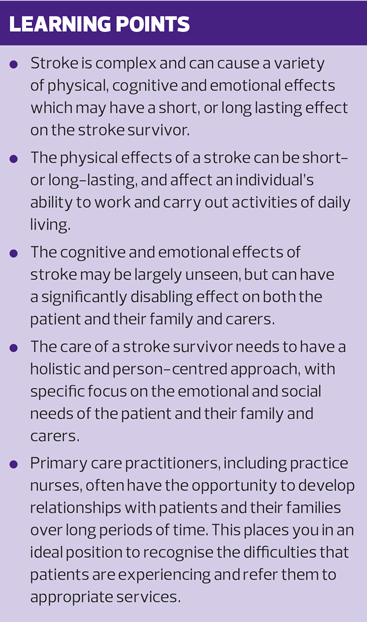Stroke survivors:the long road to recovery
MEL GREGORY
MEL GREGORY
RGN, BSc(Hons) Stroke Specialist Nurse, Kent Community Health NHS Foundation Trust.
TARA GALLOWAY
Stroke Association Interim Lead, South East Coast
Life after stroke can be challenging, and while improvements in physical disabilities can be expected, progress can be slow and intermittent. The general practice nurse can provide a useful source of information, advice and support to stroke survivors – not least by fulfilling the role of advocate
The physical, mental and emotional effects of stroke can be life-changing and devastating, and their impact long term. Currently there are around 1.2 million stroke survivors in the UK and, as more people survive a stroke, the numbers living in the community are set to rise.
Almost two thirds of stroke survivors leave hospital with a disability and, after the initial acute phase, need support in the community. They should have a discharge plan that covers all the necessary arrangements for care at home, including links with community services and any special equipment they may need.
Current National Clinical Guidelines1 recommend that people with stroke should be offered a structured health and social care review at 6 and 12 months after the stroke, and annually thereafter. They should also have the opportunity for further specialist interventions if new problems present, their physical or psychological condition or social environment changes, or if they are struggling to cope and need additional support. This service works best when health, social care and the voluntary sector work together to achieve a coordinated approach. (See activities 1 and 2)
A report from the National Institute for Health Research highlights how recovery from stroke can be long and difficult, and how survivors’ needs for health and social care support can change.2 The report brings together recent evidence relevant to those planning and delivering stroke services, delivering treatments to people with stroke and to those living with it.
PHYSICAL EFFECTS OF STROKE
Stroke is complex and survivors may face a range of longer-term problems.
Communication
Communication difficulties are one of the most common effects of stroke. These occur either as a result of damage to the parts of the brain responsible for language (aphasia) or damage to the muscles used for speaking (dysarthria). In some cases, although the person may not have facial weakness, the brain cannot co-ordinate the movement of the muscles used to produce speech sounds (verbal dyspraxia). In extreme cases, they may not be able speak, write, or recognise words on a page.
Speech difficulties can result in social isolation, loss of income and changed role in the family, giving rise to frustration, anger, depression, anxiety, loss of confidence and embarrassment.3 A stroke survivor with communication problems should be encouraged to increase their participation in social activities. This can be facilitated by a speech and language therapist guiding a volunteer or family member. The individual should also be assessed for assistive technology and communication aids by an appropriately trained, experienced clinician.
Dysphagia
Swallowing problems usually get better and most people are able to swallow safely again within the first few weeks. A small number have problems that last longer than this but only a very small number are left with lasting difficulties. However, 11–15% of stroke survivors will still have problems eating and drinking 6 months after a stroke.4
Longer term feeding and nutrition will have been considered in the acute phase and the stroke survivor may be on a modified diet or be being fed via a gastrostomy. Family members or carers need to be trained in the management of the swallowing difficulty and the patient should be regularly assessed by a speech and language therapist. A dietician should also monitor longer term for changes in weight or malnutrition.
Muscle weakness
This can vary from person to person, from facial weakness only, to unilateral arm, leg and facial weakness, depending on the severity of the stroke. Muscle weakness can result in difficulty speaking and swallowing, dribbling and altered facial expression. It can also result in watery eyes, dry eyes and infections, as well as problems with sitting, standing and walking. Only having the use of one arm, or limitations to the movement and strength of one arm, can affect grip and dexterity. Long term, muscle weakness can result in high tone spasticity, pain, and wear and tear to the unaffected limbs.
If a joint does not move frequently there is a risk that contractures will develop. The muscles around the joint shorten, leading to restricted movements. This can cause pain, make it difficult to wash and dress, and limit the individual’s ability to sit in a chair or wheelchair. People with motor weakness should therefore be regularly reviewed for signs of high tone spasticity and pain, and referred to specialist multidisciplinary spasticity services for interventions with specific, patient centred goals. These might include exercises to stretch muscles, oral muscle relaxants, intramuscular botulinum toxin or splinting.
Altered sensation
Some stroke survivors have altered, or loss of, sensation on the affected side, disrupting their ability to feel heat or cold, pain, textures, light or deep touch. This may cause difficulty with picking things up or cause them to drop things, but may also reduce their ability to respond in dangerous situations, such as withdrawing their hand from a hot object.
In contrast, altered sensation may also be manifest as hypersensitivity, causing extreme discomfort from the lightest touch.
Central Post Stroke Pain
This affects approximately 15% of stroke survivors.5 The onset of neuropathic pain may occur at the time of the stroke or several months later. The pain is described as an icy or burning sensation, throbbing or shooting pain down the side affected by the stroke.
Central post-stroke pain should be initially treated with amitriptyline, gabapentin or pregabalin, as recommended by NICE.5 Patients will need to be regularly reviewed and their medication adjusted according to their tolerance and response to therapy.
Mobility and hand function
Following a stroke, a physiotherapist will work with the patient to help them develop or regain balance, co-ordination skills and muscle strength, and will teach them to stand and move about safely. The occupational therapist manages the upper limb, encouraging movement and activity in the affected hand and arm and helping the person to re-learn everyday tasks, such as writing or eating with their unaffected hand if necessary.
Therapy can help maintain or improve movement but, after a period of intensive therapy, the stroke survivor will reach a stage when their progress slows down and plateaus. They are usually discharged from therapy at this stage but can be referred on to longer term services such as exercise referral or day hospital, if appropriate. This can be a difficult time for the stroke survivor, and their family. They may need to come to terms with the realisation that this may be ‘as good as it gets’; they may never walk or be able to use both arms, but they may also not be ready to accept that that is the end of their recovery. Making use of voluntary organisations, longer term rehabilitation services and health services such as postural stability groups or health trainer programmes can be a great help.
Continence
Continence problems tend to be worst in the very early stages after stroke. Lack of mobility can also cause constipation and managing bowels can be a challenge to stroke survivors. These problems usually improve very quickly, and most people recover their control within the first few weeks. Only around 15% of stroke survivors still have continence problems a year after their stroke.6 Even if patients do continue to have longer term problems, there is still a lot that can be done to help manage them.
It is essential to establish what is causing the incontinence and try to treat it rather than just provide incontinence pads. Stroke survivors should be referred to a specialist multidisciplinary continence service for a comprehensive assessment and treatment plan.
There are a number of treatments that can help, such as bladder or bowel training, pelvic floor exercises or medication.
Carers may feel out of their depth when faced with incontinence. They may struggle to help their loved one preserve their comfort and dignity while following a toileting routine, giving intimate care or dealing with soiled clothes and bed linen.
Specialist continence advisers are a vital source of support, and the Stroke Helpline (see Resources) can also offer advice and a listening ear.
Vision
Visual problems are common, can be distressing, and can affect the rest of a patient’s recovery. For example, they may not be able to walk confidently if they cannot fully see where they are going. Vision problems often resolve as the brain recovers, but in some cases stroke survivors are left with permanent visual impairment.
Visual problems can be significantly disabling, affecting daily activities including driving. An appropriate referral is recommended for further assistance and advice. Anyone who has had their vision affected should have a driving assessment prior to recommencing driving.
Exercises can improve eye movements where there is difficulty moving the eyes to look at objects held close to the face. A patch can also be used to eliminate troublesome double vision.
COGNITIVE EFFECTS OF STROKE
Following a stroke, many patients experience difficulties with concentration or memory. They may have problems following a TV programme, reading a book, remembering a conversation, or finding their way around. However, cognitive problems are likely to improve very quickly over the first 3 months following a stroke.
An occupational therapist can help stroke survivors learn coping strategies, such as writing in a diary, or using labels to help manage day-to-day activities. For those with severe or persistent cognitive problems specialist assessment and treatment from a clinical neuropsychologist or clinical psychologist may be appropriate.
EMOTIONAL EFFECTS OF STROKE
Anyone who experiences the life-changing impact of stroke will go through a range of emotions as they try to come to terms with it. Feelings of shock, denial, anger, grief and guilt are normal and many report bereavement-like emotions. Failure to acknowledge the loss of previous self is likely to lead to overwhelming emotions and persistent problems.7
Every stroke is different, and every survivor will be affected differently. However, their confidence may be shaken to its core. They will be living with uncertainty in a body that is never quite the same. For many it will be their first brush with their own mortality. Just as the stroke may have come out of the blue, fear of another stroke can be an overwhelming concern. Stroke can also disrupt people’s sense of self and identity, and how to engage with those around them, particularly if a patient has aphasia. Anxiety, depression and stress are all common.
Emotional lability
Sometimes a stroke affects the emotion centre of the brain producing emotional lability. Many stroke survivors report laughing at funerals or crying at a happy moment. It is more common to experience emotional lability if ability to think and reason has been compromised. However, it does not necessarily mean that other changes to thinking and reasoning will occur. There may be a trigger to the lability, but this is not always the case.
Stroke apathy
Stroke apathy is a common but misunderstood effect of stroke, leading to personality changes, loss of motivation, disengagement and withdrawal. Apathy has recently been recognised as a symptom in patients with cerebral small vessel disease, which restricts the blood supply to the brain.
Information, advice and emotional support can go a long way towards helping people better understand what’s happened, plan for the future and manage their condition. Talking therapy is known to improve outcomes for patients, by allowing time and space to talk about difficult feelings with a trained therapist. Fear of death and concerns about further strokes are common and should be explored in a safe environment. Medication may be appropriate. Antidepressants could be prescribed for low mood, but many stroke survivors do not wish to take them.
FATIGUE
Post-stroke fatigue is not like typical tiredness. It doesn’t always improve with rest and it isn’t related to how busy or active the patient has been. The incidence of post-stroke fatigue is reported to be as high as 76% and can continue over 2 years.8 Post-stroke fatigue is not fully understood. A general classification of the causes includes:
- Perception
- Physiological
- Biochemical
- Behavioural.9
The recovery process following a stroke naturally takes up energy. Simple tasks like walking, talking or eating (especially with dysphagia) will use up much more energy. Emotional problems like depression or anxiety will add to tiredness and fatigue. A recent study found that depression was the most frequent psychiatric complication of stroke.10
Comorbidities , such as hypertension, diabetes, atrial fibrillation, and the drugs to treat them, may add to or complicate fatigue. Post stroke fatigue is therefore often multifaceted and needs to be explored fully to enable appropriate treatment to be initiated.
Non-pharmacalogical interventions for overcoming fatigue include allowing plenty of time for tasks, resting frequently and increasing activity gradually. Information about stroke and meeting other stroke survivors with similar issues can help patients come to terms with its effects.
It may seem counterintuitive but exercise, starting with just a few minutes a day and building up, will improve fatigue. Stroke groups, counselling, relaxation programmes and exercise groups have all been shown to help.11
Post-stroke fatigue can range from relatively mild to severe. The intensity of the resulting tiredness does not seem to be related to the severity or type of stroke. Even if a stroke survivor has made a full, physical recovery, or their stroke was some time ago, fatigue can continue be a constant problem. There is no specific medication to treat post-stroke fatigue, but the condition can be managed. Securing a diagnosis and identifying whether there are any specific causative factors that are amenable to treatment is the first step.
RETURNING TO PREVIOUS ACTIVITIES
Many stroke survivors can lead fulfilling lives and will be able to return to work, driving, hobbies or meaningful activities. There may, however, be some barriers that will need to be addressed. Cognitive deficits, problems with attention, concentration and executive dysfunction mitigate against a return to previous activity and can affect an individual’s quality of life.12 Assessment of these areas, with appropriate referrals to employment support, Drivability or occupational therapy can be useful. If adaptations are required, organisations such as The Stroke Association can provide means tested grants for equipment.
Sexual dysfunction is a common problem for stroke survivors.13 Almost half (49%) of stroke survivors and 31% of spouses were dissatisfied with their post-stroke sex life, and 33% of stroke survivors and 27% of spouses reported completely ceasing sexual intercourse after a stroke. These findings could be due to many of the stroke effects and medications. Stroke survivors benefit from information from the health care community on potential sexual changes. There are online guides and recommendations that might assist.14
CONCLUSION
Stroke is complex and varied and will affect every stroke patient slightly differently. A full assessment of needs and issues, regular reviews and stroke education are key to assisting people in their recovery. Support to self-manage and lead a fulfilling life not only creates the best outcome for the stroke survivor, but will also lessen the burden on health care services.
In addition to stroke consultants, physiotherapists, speech and language therapists and GPs, practice nurses have an important role in providing stroke survivors with advice and support.
Stroke survivors can also learn a lot and receive ongoing emotional support from appropriate peer support.15 It is very important to address medical needs, but attention to social, emotional and environmental needs can make a wealth of difference too. For both stroke survivors and carers the Stroke Association provides support across the UK in a variety of ways, including advice and information about stroke and how people can reduce the risk of another stroke, to practical help and community based support groups to help stroke survivors make the best recovery they can.
REFERENCES
1. Royal College of Physicians. National clinical guidelines for stroke. 5th Edition. 2016. Royal College of Physicians. London. https://www.rcplondon.ac.uk/guidelines-policy/stroke-guidelines
2. National Institute for Health Research. Roads to recovery: organisation and quality of stroke services. March 2017 http://www.dc.nihr.ac.uk/themed-reviews/Roads-to-recovery-final.pdf
3. Parr S. Living with Severe Aphasia. Tracking social exclusion. Aphasiology 2007;21 [1]: 98-123
4. Mann G, Hankey G, Cameron D. Swallowing Function After Stroke Prognosis and Prognostic Factors at 6 months. Stroke 1999;30:744-748
5. NICE CG173. Neuropathic pain -pharmacological management: the pharmacological management of neuropathic pain in adults in non-specialist settings, 2013 http://guidance.nice.org.uk/CG173.
6. Stroke Association. Continence Problems after Stroke. 2012 https://www.nice.org.uk/guidance/cg148/ifp/chapter/urinary-incontinence-related-to-a-neurological-condition
7. Stroke Association. Common problems after a stroke: Emotional changes. https://www.stroke.org.uk/what-stroke/common-problems-after-stroke/emotional-changes
8. Glader EL, Stegmayr B, Asplund K. Poststroke. Fatigue: a 2-year follow-up study of stroke patients in Sweden. Stroke 2002;33:1327–1333
9. Piper BF, Lindsey AM, Dodd MJ. Fatigue mechanisms in cancer patients: developing nursing theory. Oncology Nursing Forum 1987;14:17–23
10. Chemerinski E, Robinson RG. The neuropsychiatry of stroke. Psychosomatics 2000;41:5–14.
11. Stroke Association. Stroke News, spring edition 2017. https://www.stroke.org.uk/resources/stroke-news-spring-2017
12. Ostwald SK, Godwin KM, Cron SG. Predictors of life satisfaction in stroke survivors and spousal carers following inpatient rehabilitation. Rehabilitation Nursing, 2009;34(4):160–174 http://onlinelibrary.wiley.com/doi/10.1002/j.2048-7940.2009.tb00272.x/abstract;jsessionid=540832F7D017A4FA338CB2AD86F099EB.f01t03
13. Duncan PW, Wallace D, Lai SM, et al. The stroke impact scale version 2.0: evaluation of reliability, validity, and sensitivity to change. Stroke 1999;30:2131–2140.
14. Stroke Association. Sex after Stroke. 2012 https://www.stroke.org.uk/sites/default/files/sex_after_stroke.pdf
15. The Nuffied Trust and Stroke Association. Evaluation of Stroke Association Voluntary Groups. Knowing you’re not alone: understanding peer support for stroke survivors. September 2016 https://www.nuffieldtrust.org.uk/files/2017-01/savgs-evaluation-main-web-final.pdf
Related articles
View all Articles




